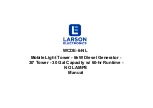
Page 8
0210-00
60706-195
properly installed, the normal A.T.S. Control and safety systems
will eliminate all paths for feedback.
To wire the automatic transfer switch into the existing wiring, first
determine which circuits will be on the emergency load circuit. If
the entire load is to be transferred, the transfer switch can be
wired in directly after the watt-hour meter and the service en-
trance, providing the service entrance ampere rating is within the
transfer switch’s rated capability.
If only specific circuits are to be powered under emergency power
failure conditions, an additional distribution panel designated
“emergency distribution panel” must be installed.
All selected emergency circuits are removed from main distribu-
tion panels and installed in the emergency distribution panel. The
A.T.S. is then installed between the main panel and the emer-
gency distribution panel. Suggested circuits: freezer, refrigerator,
furnace, emergency lights, sump pump, emergency outlet circuits,
etc. Total running load must not exceed generator rating.
A.C. ELECTRICAL
CONNECTIONS
NOTICE - CLASS 1 WIRING METHODS ARE TO BE USED FOR
ALL FIELD WIRING CONNECTIONS TO TERMINALS OF A
CLASS 2 CIRCUIT
Note: This symbol always indicates ground where
used.
INSTALLERS NOTE: To access the AC and DC inter-
connections on this unit, open the single door on the
right hand side of the units. Then remove the safety
panel covering the mainline circuit breaker. All connec-
tion are behind this panel.
A - Neutral Lugs, These neutral lugs are isolated from ground
and provided for you to connect your neutral wire from the
transfer switch to. The lugs on the 40 kW will handle wire sizes
#4 AWG to 300 MCM and should be torqued to 250 in. lbs. The
lugs on the 30 kW will accommodate #4 AWG to 300 MCM and
should be torqued to 250 in. lbs.
Never fill the battery above the fill line. Over filling above the
upper level line may cause the electrolyte to overflow, resulting in
corrosion to the engine or nearby parts. Immediately wash off
any spilled electrolyte following the procedure above.
NOTE: Always make sure that a new battery is fully charged
before installing it on a generator set. Failure to do so can cause
damage to the engine control module in the generator set.
All connections must be clean and tight. Check the electrolyte
(fluid) in the battery periodically to be sure it is above the plates.
Never allow the battery to remain in a discharged condition.
CONNECTING THE BATTERY CHARGER &
BLOCKHEATER
A two-stage battery tender is provided on all standby generators.
This battery tender charges at a rate of 750 mA until the battery is
fully charged and then automatically switches to a 13.2 VDC float
charger. The charger has an indicator light on it, red indicates it
is charging, and green indicates it is in the storage mode (float
charge). This charger is mounted on the engine generator set
just below the engine control panel.
** NOTICE **
The trickle charger is not intended to recharge a battery which
has become completely discharged. It is designed to produce
just enough current to maintain a fully charged battery.
The battery tender receptacle is to be powered by a GFCI circuit
and installed in accordance with the United States National
Electric Code. These AC wires can be run in the same conduit as
the other AC leads from the generator. It is suggested that this
circuit be fused for 15 amps, then both the battery charger and
the block heater can be connected to the same circuit. A 120 volt
duplex receptacle is mounted on the generator along side circuit
breaker panel, the battery tender is shipped already plugged into
the receptacle.
The engine blockheater installed on this unit\ should also be
plugged in this receptacle. The block heater is thermostatically
controlled and when plugged in will maintain the engine coolant
temperature between 100 and 120 degrees F.
MOUNTING THE AUTOMATIC
TRANSFER SWITCH (A.T.S.)
****************
***** WARNING *****
****************
FIRE HAZARD - All wiring must be done by a licensed electri-
cian, and must conform to the national electrical code and comply
with all state and local codes and regulations. Check with the
local authorities before proceeding!
INSTALLATION NOTES
Because of the many different types of service, feeder, and
distribution equipment, no specific wiring instructions can be
provided. It is recommended that only copper wire be used. In
all cases it is essential that while the load is connected to the
generator, there can be absolutely no feedback from the genera-
tor to the power line or the power line to the generator. When






































